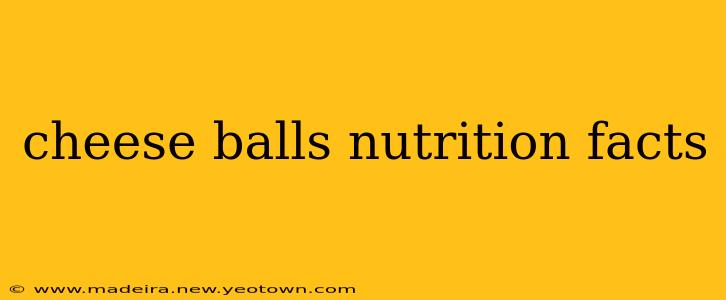Cheese balls. Those irresistible, bite-sized spheres of cheesy goodness. They grace holiday platters, cocktail parties, and family gatherings, leaving a trail of satisfied smiles (and maybe a few crumbs) in their wake. But have you ever stopped to consider the nutritional facts behind these cheesy delights? Let's embark on a culinary investigation to uncover the truth about cheese ball nutrition.
It's important to preface this by stating that the nutritional profile of a cheese ball can vary wildly depending on the recipe. Homemade cheese balls offer greater control over ingredients, while store-bought versions may contain added fats, preservatives, and other components that alter the nutritional makeup. This exploration will focus on common ingredients and offer a general overview.
What are the main ingredients in cheese balls?
The foundation of most cheese balls is, unsurprisingly, cheese! This can range from sharp cheddar and creamy cream cheese to milder options like Monterey Jack or Colby. Beyond the cheese, common additions include:
- Mayonnaise or Sour Cream: These contribute to the creamy texture and richness.
- Butter or Cream Cheese: Further enhancing the creamy texture and often adding flavor.
- Seasonings and Herbs: Garlic powder, onion powder, chives, parsley, and various spices add depth of flavor.
- Nuts or Seeds: These may be incorporated for added texture and nutritional value.
- Crackers or Breadcrumbs: Used as a binder or to create a different outer texture.
The specific ingredients and their quantities heavily influence the final nutritional content.
How many calories are in a cheese ball?
This is the million-dollar question, and unfortunately, there's no single answer. A small cheese ball (approximately 1 ounce) can range anywhere from 100 to 200 calories, depending on the ingredients. However, it's easy to consume significantly more than one ounce in a single sitting, dramatically increasing the calorie count. Calorie density is high, so portion control is essential.
What are the fats, carbohydrates, and protein levels in cheese balls?
Cheese balls are primarily comprised of fat, followed by protein and carbohydrates. The fat content stems from the cheese, mayonnaise, butter, and nuts. These fats can be a mix of saturated and unsaturated fats, so it is vital to consider the types of cheese and added fats in your chosen recipe. The carbohydrates are mainly derived from added ingredients like crackers or bread crumbs. The protein content comes mainly from the cheese itself.
Are cheese balls healthy?
The "healthiness" of a cheese ball is subjective and depends heavily on the recipe. A cheese ball made primarily from full-fat cheeses and creamy additions will be significantly higher in saturated fat and calories than a lighter version made with low-fat cheese, reduced-fat mayonnaise, and a more substantial portion of vegetables or herbs. Moderation is key. Cheese balls can be part of a balanced diet, but they should not be a staple food item.
How can I make healthier cheese balls?
If you're keen on enjoying cheese balls without the guilt, consider these healthier alternatives:
- Use lower-fat cheeses: Opt for part-skim or reduced-fat cheeses to reduce the fat and calorie content.
- Reduce the mayonnaise or sour cream: Use less of these ingredients, substituting with Greek yogurt for a healthier creaminess.
- Incorporate vegetables: Adding finely chopped vegetables like finely diced carrots, celery, or bell peppers can add nutrients and bulk.
- Choose whole-wheat crackers: Using whole-wheat crackers instead of regular crackers offers more fiber.
- Use nuts and seeds sparingly: Nuts and seeds are nutritious but calorie-dense. Use them sparingly to add flavor and texture without significantly increasing calories.
Ultimately, the nutritional value of cheese balls is highly variable and depends on the specific ingredients and quantities used. By carefully selecting ingredients and practicing mindful portion control, you can enjoy this festive treat without completely derailing your dietary goals. Remember, balance and moderation are key to enjoying your favorite foods while maintaining a healthy lifestyle.

